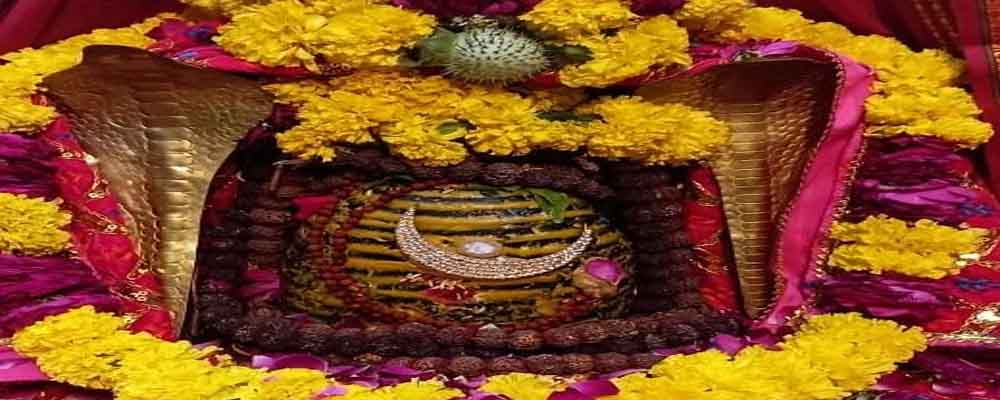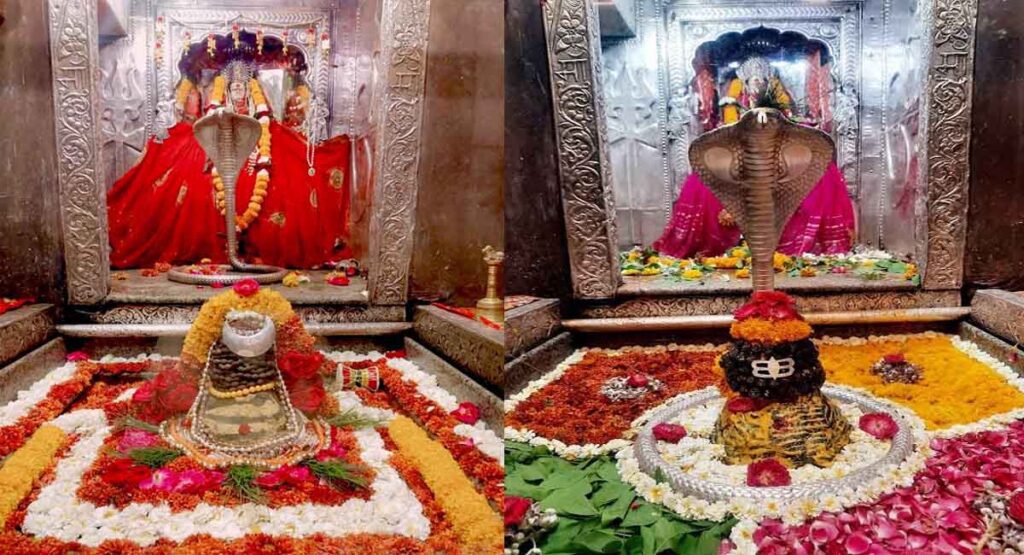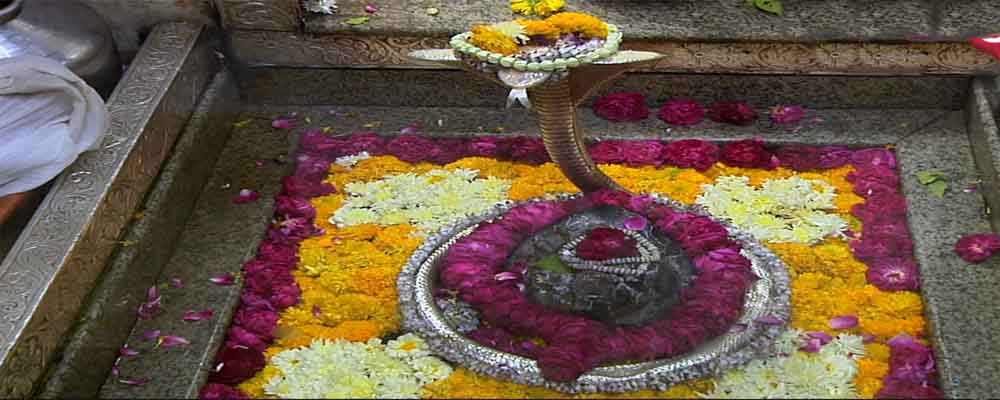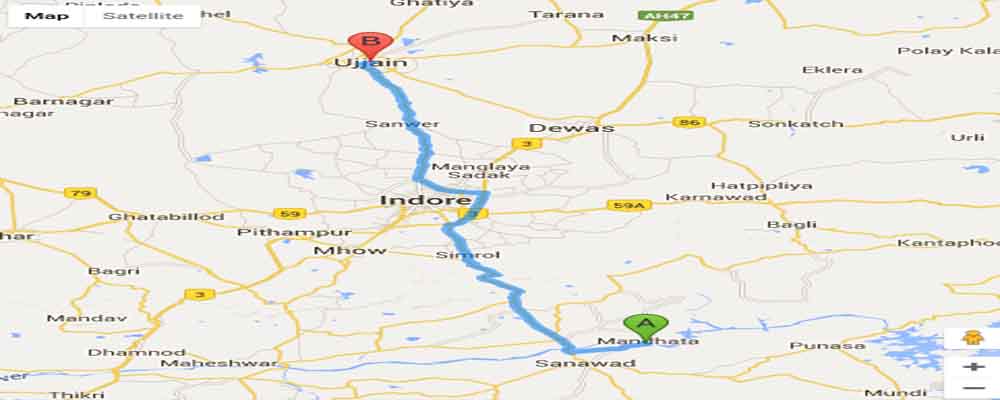The Omkareshwar temple, situated near Indore on a serene island shaped like the sacred symbol “ॐ” in the Narmada River, holds great significance in Mandhata. On the southern coast, you’ll find the Mamaleshwar temple, also known as Amareshwar in ancient times. These two temples are considered equally important and both house Shivlingas, which are revered as Jyotirlingas. Located 75 kilometers from Khandwa on the Indore-Khandwa Highway, this place holds immense spiritual value for Hindus, being one of the twelve Jyotirlingas of Omkar-Mamaleshwar. Additionally, the Siddhawar Kut of Jainism is also present here, attracting millions of devotees from different religions and even foreigners each year.

In this sacred place, you can explore various noteworthy sites. There’s the cave of Govind ji, the esteemed Guru of Adiguru Shankaracharya, who propagated the profound philosophy of Advaita. You can also discover the remnants of the grand Siddhnath temple, the enchanting Gauri Somnath temple, and the captivating Rinkmukteshwar temple. Furthermore, nearby, you’ll find the Tirtha Siddawarakut of Jainism, which houses several ancient Jain temples, some of which have been lovingly restored. The captivating images found here provide glimpses into the history of this place, dating back to as early as 1488 AD, primarily showcasing the revered Tirthankara Lord Shri Shantinath ji.
Omkareshwar Temple – Facts
| Deity | Lord Omkareshwar (Lord Shiva) |
| Location | Mandhata, Madhya Pradesh |
| Significance | Jyotirlinga |
| Ujjain to Omkareshwar Distance | 139 Kms |
| Darshan Timings | 5:00 AM to 9:30 PM |
| Entry Fee | Free |
| Puja’s | Maharudrabhisek, Laghurudrabhisek |
| Best Time to Visit | October to March |
| Festivals | Shravan, Shivratri |
| 12 Jyotirlingas | Click Here |
Omkareshwar Temple History

The history of the Omkareshwar Temple is steeped in ancient legends and religious significance. This sacred temple is dedicated to Lord Shiva and holds a prominent place in Hindu mythology and pilgrimage.
According to popular belief, it is said that once upon a time, the Devas (celestial beings) and the Asuras (demons) joined forces to churn the milky ocean to obtain the elixir of immortality. During this cosmic event, various divine objects emerged from the ocean, including a pot of poison. The gods and demons were unsure of what to do with the poisonous substance, as it had the potential to destroy the universe.
Seeking help, they approached Lord Shiva, the supreme deity known for his benevolence and power. Lord Shiva, in his divine wisdom, drank the poison to protect the universe. As a result, his throat turned blue, earning him the name “Neelkanth” (the one with a blue throat).
Impressed by Lord Shiva’s selflessness and bravery, the Devas decided to establish a sacred shrine in his honor. They chose the present-day location of the Omkareshwar Temple, situated on an island shaped like the auspicious symbol “ॐ” in the Narmada River.
The Omkareshwar Temple is also associated with the legend of King Mandhata. It is believed that the king, a devout worshipper of Lord Shiva, performed intense penance on this island, seeking the blessings and guidance of the divine. Pleased with his devotion, Lord Shiva appeared before King Mandhata and granted him a boon. As a result, the island came to be known as Mandhata Island, after the king.
Over the centuries, the Omkareshwar Temple has undergone several renovations and expansions under the patronage of various dynasties and devotees. The temple’s architecture showcases a harmonious blend of traditional Indian temple design, featuring intricate carvings, ornate pillars, and elaborate spires.
Today, the Omkareshwar Temple continues to be a revered pilgrimage site for devotees of Lord Shiva. It attracts a large number of visitors, both from within India and abroad, who come to seek blessings, offers prayers, and immerse themselves in the spiritual aura of this sacred place.
Omkareshwar Jyotirlinga

Omkareshwar Jyotirlinga holds tremendous significance in Hindu mythology and is revered as one of the twelve sacred Jyotirlingas of Lord Shiva. The term “Jyotirlinga” refers to a divine manifestation of Lord Shiva, representing his infinite and radiant form.
The legend behind the Omkareshwar Jyotirlinga revolves around the sage Narada, who once visited the sage Narayana in the sacred region of Mount Meru. Narada received a beautiful Jyotirlinga from Narayana as a divine gift and proceeded to search for the most suitable place to establish it.
While undertaking his search, Narada came across the sacred island formed by the Narmada River in the shape of the holy symbol “ॐ” (Om). He was captivated by the serene surroundings and the spiritual energy of the place. Narada decided that this would be the perfect location to install the Jyotirlinga.
Impressed by Narada’s devotion and wisdom, Lord Shiva appeared and accepted his request to reside on the island. Thus, the Omkareshwar Jyotirlinga was established, with Lord Shiva manifesting himself as “Omkareshwar,” the Lord of Om.
The Omkareshwar Jyotirlinga temple stands proudly on the island, showcasing splendid architectural beauty and intricate carvings. Devotees from all corners of the world visit this sacred site to seek the blessings of Lord Shiva and offer their prayers.
The temple complex comprises various other shrines dedicated to deities like Goddess Parvati, Lord Ganesha, and Lord Kartikeya. Pilgrims engage in rituals, perform abhishekam (ritual bathing) of the Jyotirlinga, and participate in religious ceremonies with utmost devotion.
The Omkareshwar Jyotirlinga holds immense spiritual significance, believed to bestow divine blessings and fulfill the wishes of its devotees. It is considered a revered site for seeking spiritual enlightenment, salvation, and liberation from the cycle of birth and death.
Visiting the Omkareshwar Jyotirlinga is not only an act of devotion but also an opportunity to experience the serenity and divine energy that surrounds this ancient pilgrimage site. It continues to be a cherished destination for pilgrims and devotees who embark on a sacred journey to connect with the divine presence of Lord Shiva in the form of the Omkareshwar Jyotirlinga.
Significance of Omkareshwar Jyotirlinga

The Omkareshwar Jyotirlinga holds immense significance in Hindu spirituality and is revered by millions of devotees worldwide. Here are some key aspects that highlight the significance of this sacred Jyotirlinga:
- Divine Manifestation of Lord Shiva: The Omkareshwar Jyotirlinga is believed to be a direct manifestation of Lord Shiva, representing his infinite and radiant form. It is considered a powerful symbol of his presence and divine energy.
- Pilgrimage and Spiritual Significance: Visiting and worshiping at the Omkareshwar Jyotirlinga is considered a highly auspicious pilgrimage. Devotees believe that it helps purify the soul, bestow blessings, and grant spiritual progress. It is believed that a sincere and devoted visit to this Jyotirlinga can lead to spiritual awakening and liberation.
- Connection to the Sacred River Narmada: The Omkareshwar Jyotirlinga is located on an island in the Narmada River, which itself is considered highly sacred in Hinduism. The Narmada River is believed to be divinely connected to Lord Shiva, and its association with the Jyotirlinga adds to the sanctity and spiritual aura of the pilgrimage.
- The symbolism of “Om”: The island on which the Omkareshwar Jyotirlinga is situated is shaped like the sacred symbol “ॐ” (Om), which is considered the primordial sound of the universe. The presence of the Jyotirlinga on this island is seen as a harmonious blending of the physical and spiritual realms, representing the cosmic significance of Lord Shiva.
- Fulfillment of Devotees’ Desires: It is believed that sincere prayers and devotion to the Omkareshwar Jyotirlinga can fulfill the desires and wishes of devotees. Many pilgrims visit with specific intentions, seeking blessings for health, prosperity, harmony, and spiritual upliftment.
- Cultural and Historical Importance: The Omkareshwar Jyotirlinga has a rich historical and cultural heritage associated with it. The temple complex itself showcases architectural brilliance and intricate carvings, attracting enthusiasts of art and history in addition to religious devotees.
Overall, the Omkareshwar Jyotirlinga holds great reverence and is considered a sacred center of divine energy, offering spiritual solace, blessings, and the opportunity for devotees to connect with the transcendental aspect of Lord Shiva. It is a place where faith, devotion, and spirituality converge, making it an integral part of Hindu religious traditions and a cherished pilgrimage destination for millions.
Omkareshwar Jyotirlinga Puja’s

The Omkareshwar Jyotirlinga is a revered pilgrimage site dedicated to Lord Shiva. Various poojas and rituals are performed at the temple to seek the blessings of Lord Shiva and to offer devotion. Here are some of the significant poojas and rituals associated with the Omkareshwar Jyotirlinga:
- Abhishekam: Abhishekam is a ritualistic bathing of the Jyotirlinga with sacred substances such as milk, water, honey, ghee, and sandalwood paste. Devotees can participate in the abhishekam and offer these holy offerings to Lord Shiva while chanting prayers and mantras.
- Rudrabhishekam: Rudrabhishekam is a special form of abhishekam performed with offerings specifically focused on Lord Shiva’s form as Rudra. It involves the chanting of sacred verses from the Rudram, offering of various items like water, milk, bilva leaves, and performing the ritual bath while invoking the blessings and grace of Lord Shiva.
- Mahapooja: Mahapooja is a comprehensive and elaborate pooja conducted at the Omkareshwar Temple. It involves the recitation of Vedic mantras, offering of flowers, incense, and lamps, and the performance of sacred rituals with utmost devotion and reverence.
- Aarti: Aarti is a daily ritual of worship involving the offering of lighted lamps to the deity. At the Omkareshwar Temple, the evening aarti, known as the “Sandhya Aarti,” is a significant ceremony where devotees gather to witness the divine spectacle and offer their prayers.
- Parikrama: Parikrama refers to the circumambulation of the temple or the sacred shrine. Devotees often perform parikrama around the Omkareshwar Jyotirlinga, expressing their devotion and reverence towards Lord Shiva.
- Narmada Aarti: Every evening, a magnificent Maha Aarti takes place on the banks of the sacred River Narmada. This enchanting ceremony provides a breathtaking spectacle as devotees gather to witness and participate in the aarti.
- Bhagavan Bhog: Each evening, devotees have the opportunity to present Lord Shiva with a Naivedyam Bhog (offering). The Bhog typically consists of pure Ghee, Sugar, and Rice, symbolizing devotion and gratitude.
- Mundan (Tonsure): Devotees also have the option to perform Mundan, which refers to the ritual of shaving off one’s hair as an act of devotion. This ritual can be performed at the temple premises for a nominal fee.
- Special Festivals: During major Hindu festivals like Mahashivratri and Kartik Purnima, the Omkareshwar Temple witnesses a surge of devotees. Elaborate rituals, special poojas, and processions are organized during these festive occasions to celebrate the glory of Lord Shiva.
It is advisable to check with the temple authorities or priests for the specific timings and procedures of these poojas and rituals, as they may vary based on the temple’s customs and traditions. Participating in these sacred ceremonies and performing poojas at the Omkareshwar Jyotirlinga is believed to bring spiritual blessings, peace, and fulfillment to the devotees.
Omkareshwar Mandir Timings

The Omkareshwar Temple welcomes devotees from 5 AM until 9:30 PM, offering ample time for spiritual exploration and participation in various sacred rituals. Throughout the day, the temple conducts a series of rituals, allowing devotees to actively engage in their spiritual journey. One such opportunity is the morning, afternoon, and evening aarti, where devotees can partake in the divine ceremony, experiencing the uplifting atmosphere and offering their heartfelt prayers and devotion.
| Timings | From | To |
| Morning Darshan | 5:00 AM | 3:50 PM |
| Evening Darshan | 4:15 PM | 9:30 PM |
| Mangal Aarti | 5:00 AM | 5:30 AM |
| Jalabhishek | 5:30 AM | 12:25 PM |
| Evening Aarti | 8:20 PM | 9:05 PM |
Ujjain to Omkareshwar Distance

The distance between Ujjain and Omkareshwar is approximately 150 kilometers (93 miles). The route typically followed by road is via the NH52 and SH27. The journey duration can vary depending on the mode of transportation and the traffic conditions, but it generally takes around 3 to 4 hours to reach Omkareshwar from Ujjain by car or bus. It is advisable to check for real-time traffic updates and plan the trip accordingly.
Indore to Omkareshwar Distance
The distance between Indore and Omkareshwar is approximately 77 kilometers (48 miles). The most commonly traveled route is via NH52 and SH27. The journey duration can vary depending on the mode of transportation and the traffic conditions, but it generally takes around 2 to 3 hours to reach Omkareshwar from Indore by car or bus. It is recommended to check for real-time traffic updates and plan the trip accordingly to ensure a smooth and timely journey.
Omkareshwar Dam Project

The Omkareshwar Dam, also known as the Omkareshwar Project, is a multipurpose dam located on the Narmada River in Madhya Pradesh, India. It is named after the nearby Omkareshwar Jyotirlinga Temple, which holds great religious significance. Here are some key details about the Omkareshwar Dam:
- Purpose: The primary purpose of the Omkareshwar Dam is to generate hydroelectric power and provide irrigation water for the surrounding agricultural areas. It plays a crucial role in the water resource management of the region.
- Construction: The construction of the dam began in 2003 and was completed in 2007. It is a joint project of the Madhya Pradesh government and the National Hydroelectric Power Corporation (NHPC).
- Dam Specifications: The Omkareshwar Dam is a concrete gravity dam with a height of approximately 59 meters (194 feet) and a length of around 1,200 meters (3,900 feet). It has the capacity to store a large volume of water, which is utilized for various purposes.
- Hydroelectric Power Generation: The dam has a power generation capacity of 520 MW and consists of eight Francis turbines, each with a capacity of 65 MW. The hydropower generated from the dam contributes to the state’s electricity supply and helps meet the growing energy demands.
- Irrigation Benefits: The stored water from the dam is used for irrigation purposes, providing a vital source of water for agriculture in the surrounding areas. It helps improve agricultural productivity and supports the livelihoods of the local farming communities.
- Tourism and Recreation: The Omkareshwar Dam has also become a popular tourist attraction. Visitors can enjoy scenic views of the dam and the surrounding landscape. Boating facilities are available, allowing tourists to explore the reservoir and experience the serene beauty of the area.
The Omkareshwar Dam stands as an important infrastructure project, contributing to both the economic development of the region and the overall well-being of the local communities through power generation and irrigation facilities.
How to Reach Omkareshwar 2024

| Mode of Transportation | Description |
|---|---|
| By Road | Omkareshwar is well-connected by road. You can reach the destination by private car, taxi, or bus. The nearest major cities with good road connectivity are Indore, Ujjain, and Khandwa. |
| By Train | The nearest railway station to Omkareshwar is Omkareshwar Road Railway Station, located about 12 kilometers away. Trains from major cities like Indore, Ujjain, and Khandwa have connections to this station. From there, you can hire a taxi or take a bus to reach Omkareshwar. |
| By Air | The nearest airport to Omkareshwar is Devi Ahilya Bai Holkar Airport in Indore, which is well-connected to major cities in India. From the airport, you can hire a taxi or take a bus to reach Omkareshwar, which is approximately 77 kilometers away. |
It’s important to note that the information provided here is subject to change, and it’s recommended to check for the latest transportation options and schedules before planning your trip to Omkareshwar.
Things to Do and See in Omkareshwar 2024

When visiting Omkareshwar, there are several attractions and activities that you shouldn’t miss. Here are some of the things to do and see in Omkareshwar:
- Omkareshwar Temple: Start your journey by visiting the famous Omkareshwar Temple, situated on Mandhata Island. Marvel at the impressive architecture and intricate mural paintings and carvings that adorn the temple.
- Gaudi Somnath Temple: Take a detour to the left of Shri Omkar Mandhata and climb 287 steps to reach the 11th-century Gaudi Somnath Temple. From there, you can descend the hill to the northern part of the island, enjoying panoramic views along the way. Alternatively, you can ascend the inner staircase of the temple and observe the playful langurs and monkeys.
- Siddhanatha Temple: Explore the elegant Siddhanatha Temple, known for its exquisite elephant carvings adorning its base. Admire the craftsmanship and the serene atmosphere of this ancient temple.
- Indulge in Local Cuisine: Treat yourself to delicious breakfasts, refreshing lassis, and mouthwatering fruit salads at the cozy cafes in Getti Chowk. If you’re looking for a more substantial meal, head to Om Shiv Restaurant, known for its delightful dishes, including thalis (platters).
- Visit Other Temples: Apart from the Omkareshwar Temple, there are several other notable shrines worth exploring in the area. Some of them include the Mamaleshwar Temple, Satmatrika Temples, Ranmukteshwar Temple, Gauri Somnath Temple, and Kedareshwar Temple. Each temple offers its unique architectural and spiritual experience.
While exploring Omkareshwar, take the time to soak in the spiritual atmosphere, witness the religious rituals, and interact with the locals to get a deeper understanding of the rich cultural heritage of the region.
Hotels in Omkareshwar

When visiting Omkareshwar, there are several hotels and accommodations available for travelers to choose from. Here are some hotels that you can consider:
- Narmada Retreat: Located near the Omkareshwar Temple, Narmada Retreat offers comfortable rooms with modern amenities and a serene ambiance. The hotel also provides a restaurant and a rooftop area with panoramic views of the surroundings.
- MPTDC Tented Accommodation: Managed by Madhya Pradesh Tourism Development Corporation (MPTDC), this tented accommodation provides a unique experience for travelers. Set amidst nature, the tents offer basic amenities and a tranquil environment.
- Hotel Shri Radhe Krishna: Situated close to the Omkareshwar Temple, Hotel Shri Radhe Krishna offers well-furnished rooms with essential facilities. The hotel has a restaurant serving vegetarian cuisine and provides a peaceful stay for pilgrims.
- Hotel Om Shiva: Located near the main market area, Hotel Om Shiva offers comfortable rooms with modern amenities. The hotel has an in-house restaurant serving a variety of dishes.
- Hotel Om Residency: Situated in the heart of Omkareshwar, Hotel Om Residency offers well-appointed rooms with amenities like air conditioning, Wi-Fi, and attached bathrooms. The hotel also provides a restaurant serving vegetarian food.
- Hotel Keshar Residency: This budget-friendly hotel offers clean and comfortable rooms for a convenient stay. It is located near the Omkareshwar Temple and provides basic amenities to guests.
- Hotel Omkareshwar Palace: Located in close proximity to the Omkareshwar Temple, Hotel Omkareshwar Palace offers comfortable rooms with modern amenities. The hotel features a restaurant serving vegetarian cuisine and provides a peaceful ambiance for a relaxing stay.
- Narmada Resort: Situated amidst lush greenery, Narmada Resort offers a serene and picturesque setting for travelers. The resort provides well-appointed rooms, a swimming pool, and a restaurant serving a variety of dishes.
- Hotel Shri Radhe Krishna Palace: Another option near the Omkareshwar Temple, Hotel Shri Radhe Krishna Palace offers comfortable rooms with essential amenities. The hotel features a restaurant and provides a convenient stay for pilgrims.
- Hotel Satyam Residency: Located near the bus stand, Hotel Satyam Residency offers budget-friendly accommodation with clean and cozy rooms. The hotel provides essential facilities and is a convenient choice for travelers on a tight budget.
- Hotel Karan Palace: Situated in a peaceful area, Hotel Karan Palace offers comfortable rooms with basic amenities. The hotel has a restaurant serving vegetarian food and provides a hassle-free stay for guests.
- Hotel Abhinav Omkareshwar: This budget-friendly hotel offers clean and simple rooms for travelers. It provides essential amenities and is conveniently located near the Omkareshwar Temple
Remember to check the availability, specific amenities, and reviews of each hotel before making a reservation. Additionally, it’s advisable to book your accommodation in advance, especially during peak tourist seasons or religious festivals, to secure your preferred choice.
Frequently Asked Questions
In which city is Omkareshwar situated?
Omkareshwar is situated in the state of Madhya Pradesh, India. It is located on an island in the Narmada River, in the Khandwa district.
What is special about Omkareshwar?
Omkareshwar holds great religious significance in Hinduism as it houses one of the twelve revered Jyotirlingas of Lord Shiva. The island itself is shaped like the sacred symbol “ॐ” (Om), adding to its spiritual aura. The convergence of the Narmada River and the presence of the Jyotirlinga make it a revered pilgrimage destination for devotees seeking blessings and spiritual fulfillment.
What is the time of Omkareshwar darshan?
The Temple is open for darshan (worship and viewing of the deity) throughout the day. Generally, the temple opens early in the morning, around 5:00 AM, and remains open until around 9:30 PM. Devotees can visit the temple at their convenience during these hours.
What time is Omkareshwar Aarti in the evening?
The evening aarti (ritual of worship with lighted lamps) at Omkareshwar Temple usually takes place around 7:00 PM. However, it’s important to note that aarti timings can vary, so it’s recommended to check with the temple authorities or inquire locally about the exact time of the evening aarti during your visit.
Is one day enough for Omkareshwar Temple?
One day can be sufficient to visit Temple, especially if you plan your itinerary well. You can explore the temple, participate in the rituals, and take in the serene surroundings. However, if you wish to delve deeper into the spiritual and cultural aspects, or if you want to explore the nearby attractions and enjoy the scenic beauty, you may consider extending your stay to fully immerse yourself in the experience.

